Speech Trust and Prosperity
Thank you for the invitation to address CEDA's annual dinner. It has become a tradition at these dinners for the Governor of the RBA to talk about how we secure Australia's continued economic prosperity. I would like to continue that tradition tonight.
My focus is going to be on the importance of trust as an essential building block of economic prosperity.
This focus is a bit different from the normal turf of economists: things like productivity, investment and capital accumulation. Of course, we need to keep a close eye on these issues, but in doing so we should not lose sight of the fact that our economy, and our society, works best when there are high levels of trust. And those in whom trust has been placed need to do their best to be worthy of that trust.
There is an element of trust in all economic transactions. Without it, commerce can't flourish. But the nature of trust in our society is changing. We can all think of recent examples where trust in our institutions and organisations has been severely tarnished. At the same time, changes in technology mean that we are increasingly trusting the wisdom of the crowd on our preferred online platforms, rather than our traditional institutions. As some have argued, trust is now more likely to be distributed, rather than to flow vertically from our institutions. This is a significant change. But regardless of how that trust is earned and retained, we all have a strong interest in living in a high-trust society.
I would like to use this theme of trust to talk about three broad issues this evening.
The first is the role of trust in finance.
The second is the importance of the community having trust that living standards will improve over time.
And the third is trust in institutions. Here, naturally enough, I will focus on the central bank and the importance of accountability and transparency. In this context I will end with a few words about current monetary policy.
Trust in Finance
Finance is all about trust. When a deposit is placed in a bank, we trust it will be repaid. We also trust financial institutions to invest our hard-earned savings for us. And we trust them to provide us with sound advice. Without this trust, the financial system cannot operate properly and the economy cannot prosper. As the first line of the Banking and Finance Oath says: ‘Trust is the foundation of my profession’.[1] I encourage everybody in the finance sector to read this oath regularly and to live by it.
Australia's banks have a strong record of being worthy of the trust that is placed in them to repay deposits. The last bank failure in Australia that resulted in a loss to depositors was almost 90 years ago, back in 1931, and it was a very small bank and depositors lost only a small fraction of their deposits.[2] This is a positive record that few countries can match. This strength was apparent during the financial crisis a decade ago and has served Australia well. The Australian banks are strongly capitalised and have considerable liquidity buffers. On the whole, they have also managed credit risk effectively, reporting few problem loans by global standards. This means that we can have a high level of trust in the ability of Australia's banks to repay depositors. Indeed, our strong and stable banking system is one of the Australian economy's strengths.
It is in other areas, though, where trust has been strained. It is clear that the behaviours highlighted by the Royal Commission have dented the community's trust in parts of our financial sector.
The case studies used by the Commission have put the spotlight on three important issues:
- the inadequate way in which banks have dealt with conflict of interest issues;
- the way that poorly designed incentive systems can distort behaviour – promoting a sales culture at the expense of a service culture, and promoting the short term at the expense of the long term; and
- the fact that the consequences for not doing the right thing have, in some cases, been too light.
Strengthening trust in our financial institutions requires all three issues to be addressed.
Central to this task is creating a strong culture of service within Australia's financial institutions. Too often our financial institutions prioritised sales over service. Correcting this starts with the system of internal reward established by the board and management. The vast bulk of the people who work for Australia's financial institutions do want to do the right thing, and they do want to serve their customers as best they can. But, like everybody else, they respond to the incentives they face. If they are rewarded on sales or short-term objectives, it should not come as a great surprise that that's what they prioritise. So establishing the right incentives is key.
One of the things that influences incentives is the consequences and penalties that apply when something goes wrong. Strong penalties can play an important role in incentivising good behaviour, and this is an area we should be looking at. But we do need to get the balance right as there can be unintended consequences.
In my view, it is worth making a distinction between the penalties that apply for poor conduct and those that apply for making loans that ultimately cannot be repaid. On conduct issues, we should set our expectations and standards high, and if they are not met the penalties should be firm. On lending, matters are more complex. Even when banks lend responsibly, a percentage of borrowers will end up in financial strife and be unable to meet their obligations. We need banks to be prepared to make loans in the full expectation that some borrowers will not be able to pay them back. Banks need to take risk and manage that risk well. If they become afraid to lend simply because of the consequences of making a loan that goes bad, our economy will suffer. So a balance needs to be struck here.
More broadly, having clear lines of accountability can help build trust. The Banking Executive Accountability Regime (BEAR) is helpful here. This regime is, however, largely limited to authorised deposit-taking institutions and to prudential matters. It is worth thinking about how the same focus on accountability can be applied to a broader range of financial services and to conduct issues as well. As we do this, though, we should not lose sight of the fact that it is the banks' boards and management that are ultimately responsible for the choices that banks make. It is unrealistic to expect that an appropriate culture can be created through regulation and penalties. Creating the right culture is a core responsibility of boards and management.
Changes that are now taking place within the financial sector should, over time, help restore trust, although it is likely to be a gradual process. The Royal Commission will have recommendations that should assist with this. One thing that would help is for financial institutions to have a long-term focus and reflect that in their internal incentives. Managing to short-term targets might boost the share price for a while, but this short-termism can weaken the long-term franchise value of the bank. We have seen evidence of this recently.
I would argue that the franchise value is more likely to be maximised if our financial institutions have a long-term perspective, treat their customers well, reward loyalty rather than take advantage of it, and invest in systems and technology that deliver world-class financial services for Australians. Doing this would not only be good for bank shareholders, but also for the broader community.
Trust That Living Standards Will Improve over Time
I would now like to turn to a slightly different concept of trust, but one that is no less important: that is, the community's trust that real living standards will improve over time.
On many accounts, the Australian economy has performed very well over recent times. Over the past year it has grown by close to 3½ per cent, inflation has been low and stable at around 2 per cent, employment has grown quite strongly and we are getting closer to full employment (Graph 1). Business conditions are positive and government finances have improved and are in reasonable shape. There is a lot of investment in infrastructure taking place and the number of job vacancies is at a record high. So, overall, it is quite a positive picture.
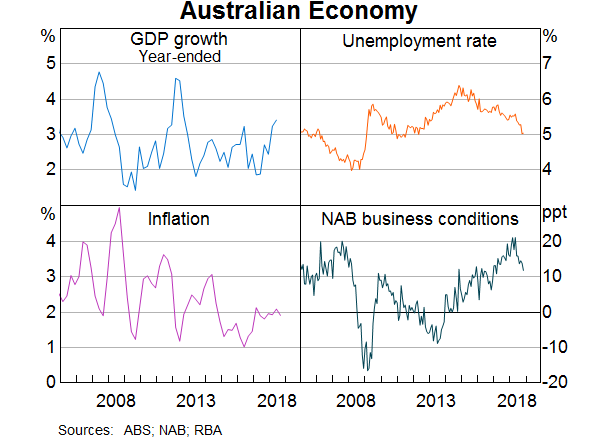
Yet, despite how often this story is told, not everybody shares this positive assessment.
This next graph helps explain why this is so (Graph 2). It shows how average hourly earnings in Australia, adjusted for inflation, have changed over time. The picture is pretty clear. Over the period from 1995 to 2012, we witnessed a substantial lift in real hourly earnings; on average real wages increased by almost 2 per cent per year. This occurred alongside inflation averaging around the midpoint of the 2–3 per cent target range and strong growth in corporate profits. Since 2012, though, it has been a different story: over these six years, there has been little change in average real hourly earnings. The wage increases that have occurred have been broadly matched by inflation.
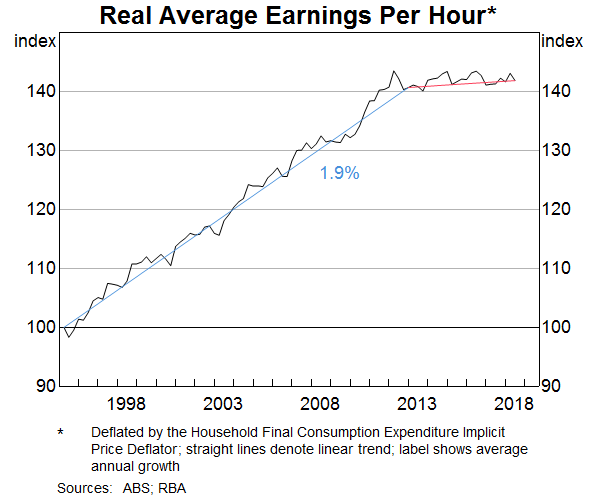
This is quite a change and it is having significant effects. On the positive side, flat real wages have supported the substantial gains in employment that we have seen. So they have benefited many people. At the same time, though, flat real wages are diminishing our sense of shared prosperity. The lack of real wage growth is one of the reasons why some in our community question whether they are benefiting from our economic success.
This is not a uniquely Australian story. A similar thing has happened across most of the advanced economies. As a result, too many citizens around the world have diminished trust in the idea that the policies that have underpinned growth over the past 30 years are working for them. They feel more uncertain about the future and, in some countries, are also having to deal with very high housing prices. This unease is despite unemployment rates in many advanced economies being the lowest in many decades.
The diminished trust in the idea that living standards will continue to improve is a major economic, social and political issue. It underlies some of the political changes we are seeing around the world. It is also making it harder to implement needed economic reform. It is in our collective interest that this trust is restored.
This is a challenging task, but it is not an impossible one. Part of the solution is for the labour market to tighten further and for this to lead to a pick-up in household income growth. The current setting of monetary policy is encouraging this. As the labour market has tightened in Australia over the past year, there has been a modest lift in wages growth. We received further confirmation of this last week with the publication of the wage price index. The RBA also continues to hear reports of larger wage rises in areas where there is strong demand for labour and workers are in short supply. We expect to hear more such reports over time.
From a longer-term perspective, another part of the solution is to boost our productivity. The factors that are contributing to flat real wages for many workers are complex, but many of them are linked to globalisation and technology. The best way of dealing with this is not to ignore these forces, but to do what we can to capitalise on them. This means government and business having a sharp focus on the question of how we can best flourish in this world of global markets and continuing improvements in technology.
An important part of the answer must be investment in education and skills, and in research and development. We need to be thinking long term here. Realistically, more investment in human capital will not make much difference to real wages this year or next. But over the next decade or two, it is crucial to raising real wages and living standards. Increasingly, our prosperity rests on the ideas that we have, how we can take advantage of those ideas, and how we can capitalise on new technologies. This means that having a strong culture of innovation in our businesses is important. With the right investments, Australians can enjoy high and rising real wages in a highly competitive and technically sophisticated world.
There are other elements to lifting productivity: the design of our tax system, the quality and pricing of our infrastructure and the strength of competition in our markets.
The key point here is that raising productivity and ensuring a strong economy will, over time, help deal with the diminished trust that people have in the idea that their real living standards will improve. We all have a strong interest in that trust being restored. Without it, a lot of things become more difficult.
Trust in the Central Bank
I would now like to turn to a third aspect of trust – that is trust in public institutions. One of Australia's strengths is that we have strong and stable public institutions. We can sometimes take this for granted. But strong public institutions are one of the foundations upon which our economic prosperity is built. They help support the public's trust in the development and implementation of economic policy, and in the fair and effective administration of laws and regulation. They can also help society balance some of the difficult trade-offs that we sometimes face.
I hope you see the Reserve Bank of Australia as one of those institutions. We have been entrusted with important responsibilities by the Australian parliament and the government: determining Australia's monetary policy; issuing Australia's currency; operating the core of Australia's payment system; acting as the banker for the Australian Government; and having broad responsibilities for financial stability and for competition, efficiency and stability in the Australian payments system.
As we carry out these responsibilities, I am very conscious that as central bankers we are unelected officials acting on the public's behalf. Reflecting this, the first of our internal values at the RBA is to act in the public interest. We work hard to be worthy of the trust that has been placed in us. We seek to do this by speaking and acting independently, consistent with our mandate, by being analytical and pragmatic in our approach to policy and by being accountable and transparent.
One element of transparency is the release of minutes on monetary policy shortly after each monthly board meeting. The latest minutes were released this morning. These contain our assessment that the Australian economy has been doing well recently. It is growing a bit faster than average, the unemployment rate is trending lower and inflation is low and stable. We expect this to continue for a while yet. This is evident in this next chart, which shows our central forecasts of GDP growth and inflation over the next few years (Graph 3). Growth this year and next is expected to exceed 3 per cent, before easing in 2020 as the boost from the large increase in liquefied natural gas exports tapers off. Inflation is expected to pick up gradually, but to remain low. The graph also shows the range of uncertainty, based on historical experience. While the public focus is normally on the central scenario, it is important to recall that the range of possible outcomes is quite large.
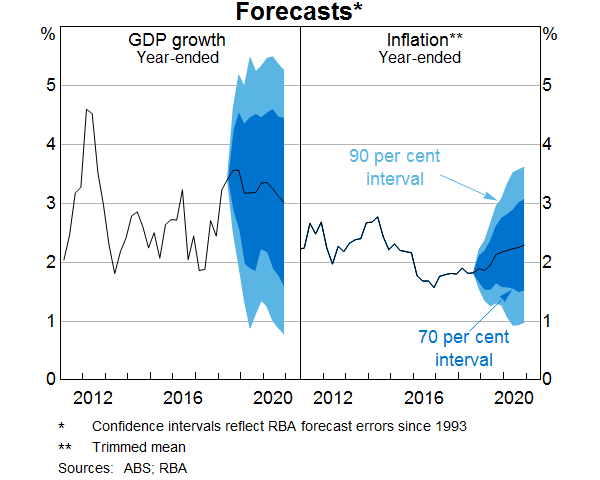
As the minutes discuss, one of the current sources of uncertainty is the pace of growth in consumer spending. Over the past couple of years, consumer spending has been growing reasonably firmly and faster than disposable income. Our central scenario is for household spending to continue growing at around its current rate and for income growth to pick up to be in line with spending growth. But there are conflicting forces at work. The strong employment growth is positive for income and consumption growth. But working in the other direction are flat real wages at a time when debt levels are high and housing prices are falling in our largest cities. We are continuing to assess the balance of these forces.
As we do this, we are watching the housing market closely. There has recently been considerable public attention paid to declining housing prices in Sydney and Melbourne. It is important to remember that these declines come after very large run-ups in housing prices in these two cities, which made purchasing a home difficult for a significant number of people (Graph 4). It is also worth pointing out that this adjustment is taking place against the backdrop of a strong world economy, a positive Australian economy, low unemployment, low interest rates, strong population growth and only limited pockets of excess housing supply. This is a reasonably favourable backdrop against which to be having an adjustment in the housing market. But we do need to watch things closely.
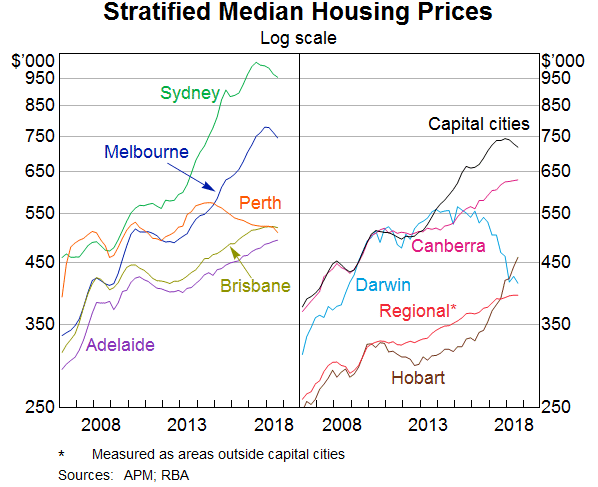
The minutes also report that the Board evaluated the forecasts made by the Bank this time last year. The Board does this type of evaluation exercise annually. Over the past year, the economy performed more strongly than expected a year ago and the unemployment rate came down by more than expected. At the same time, though, the stronger growth and labour market did not translate into more inflation; wages growth and inflation turned out to be pretty close to expectations.
| GDP Growth (Jun qtr) |
Unemployment Rate (Sept) |
Wages Growth(b) (Jun qtr) |
Underlying Inflation(c) (Sept qtr) |
|
|---|---|---|---|---|
| Actual | 3.4 | 5.0 | 2.1 | 1.8 |
| Forecast as at November 2017 | 2¾ | 5½ | 2¼ | 1¾ |
| Forecast error | 0.8 | 0.5 | 0.1 | 0.0 |
| Historical average 1-year-ahead forecast error(d) | 0.9 | 0.4 | 0.3 | 0.4 |
| (a) As at November 2018 Reserve Bank Board
meeting (b) Wage price index (c) Trimmed mean (d) 25-year average for GDP growth, unemployment rate and underlying inflation; 14-year average for wages growth Sources: ABS; RBA |
||||
The fact that growth was stronger than expected is largely accounted for by a positive surprise on both mining and non-mining investment. The terms of trade were also stronger than expected, which, combined with a lower exchange rate, helped too. The positive story for non-mining investment can be seen in this next graph, which shows the Bank's successive forecasts over the years as well as the actual outcomes – the black line (Graph 5). For a number of years we were forecasting a lift in investment that did not come. During this period of flat business investment, Glenn Stevens gave speeches bemoaning the lack of animal spirits in the business community. But over the past couple of years, things finally turned around. The long-forecast pick-up in investment finally arrived and it has been stronger than expected. We expect this upswing in investment to continue for a while yet.
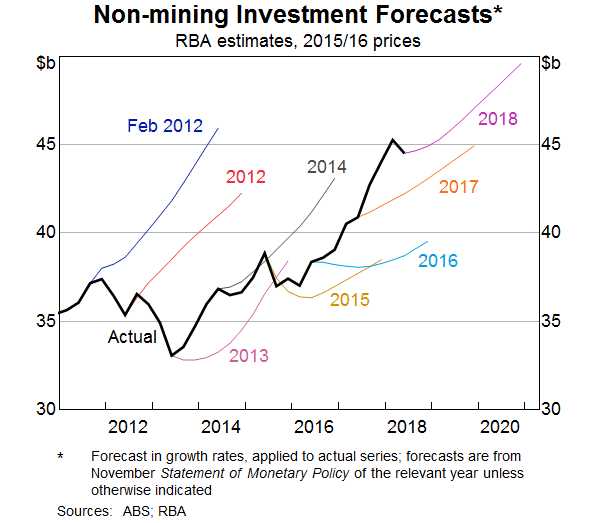
In the context of its forecast evaluation, the Board at its recent meeting also reviewed the various arguments that have been made by commentators for alternative courses of monetary policy. The timing of this review has no particular policy significance. It is good practice to consider the issues and arguments from all angles, and we do this as part of our regular processes.
As you know, following its deliberations at the November meeting, the Board again decided to maintain the cash rate at 1.5 per cent, where it has been since August 2016.
The central messages also remain the same.
First, the economy is moving in the right direction and further progress is expected in lowering unemployment and having inflation consistent with the target.
Second, the probability of an increase in interest rates is higher than the probability of a decrease. If the economy continues to move along the expected path, then at some point it will be appropriate to raise interest rates. This will be in the context of an improving economy and stronger growth in household incomes.
Third, the Board does not see a strong case for a near-term change in interest rates. There is a reasonable probability that the current setting of monetary policy will be maintained for a while yet. This reflects the fact that the expected progress on our goals for unemployment and inflation is likely to be gradual. The Board's view is that it is appropriate to maintain the current setting of policy while this progress is made.
Thank you for listening. I look forward to your questions.
Endnotes
I would like to thank Andrea Brischetto for assistance in the preparation of this talk. [*]
See the Banking and Finance Oath website at <https://www.thebfo.org/home>. [1]
The Primary Producers Bank was wound up in 1931. The bank accounted for less than 0.5 per cent of Australian banks' deposits at the time, and the bank's customers lost just 1.25 per cent of their deposits. See Fitz-Gibbon B and M Gizycki (2001), ‘A History of Last-resort Lending and Other Support for Troubled Financial Institutions in Australia’, RBA Research Discussion Paper No 2001-07. [2]
